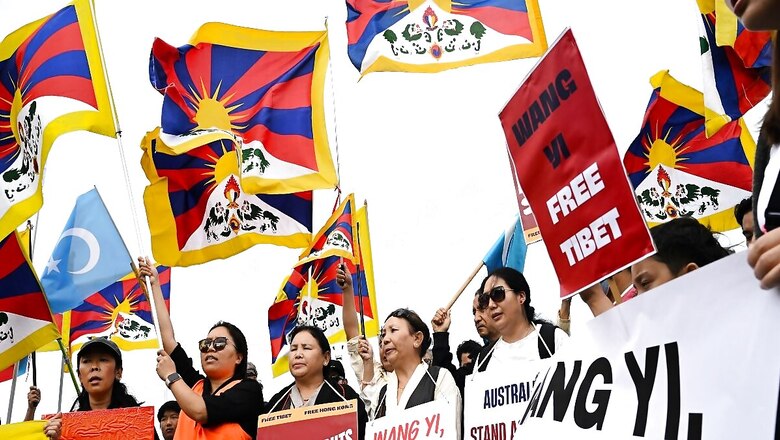
views
Around 73 years ago, on 23 May, the ‘Seventeen-Point Agreement’ was signed between the People’s Republic of China (PRC) and the Tibetan government headed by His Holiness the Dalai Lama. Claimed by China as the “Measures for the Peaceful Liberation of Tibet’, this agreement officially established Chinese legitimacy over Tibet. However, the 1951 Seventeen-Point Agreement and the developments in its aftermath soon attracted controversy, exposing the Chinese government’s imperialist intent and the start of what is currently known as the decades-old Tibetan issue, reflected in Tibetans’ prolonged fight of protecting their identity and territorial autonomy.
The Tibetan issue is essentially a conflict over history, for the Chinese and Tibetans have had contention regarding Tibet’s sovereignty prior to the 1951 agreement. While the Chinese believe that Tibet did not possess any sovereignty when the Qing dynasty fell in 1912, the Tibetans are of the opinion that Tibet has always been a sovereign nation, with occasional suzerainty over it exercised by the Mongolian, Nepalese, Chinese and the British at different periods of time.
Notwithstanding the contention, the fact remains that the Seventeen-Point Agreement is the only agreement that the Chinese government has signed with any non-Han ethnic group. Which brings to the question, why did China enter into an agreement in 1951, if Tibet was already a sovereign part of China? Traditionally, Tibet comprised three provinces – central Tibet (called Chamdo), Kham (in the south) and Amdo (in the northeast). The first attack on Tibetan sovereignty by the CCP took place in 1950, what came to be known as the Battle of Chamdo.
However, fearing Tibetan resistance, the Chinese quickly opted for negotiations to subjugate the entire Tibet under the garb of peaceful agreement. This resulted in the CCP-drafted Seventeen-Point Agreement in 1951, with Ngabo Ngawang Jigme, former Chamdo’s governor-general, representing the Tibetan delegation.
These were salient points of the agreement: The agreement recognised Tibet as part of China (Point 1), with China being responsible for Tibet’s external affairs (Point 14). Moreover, with the Tibetan government’s assistance, the Chinese military was to enter Tibet and consolidate its national defences (Point 2). At the same time, Tibet’s right to exercise autonomy was also recognised (Point 3). The CCP also guaranteed that the existing political system, functions, and powers of the Dalai Lama and Panchen Lama would remain unaltered (Point 4), while the religious beliefs and customs of the Tibetan people would be respected and protected (Point 7). Internal reforms were to be implemented only after consultation with the Tibetan leaders (Point 11).
Thus, the Seventeen-Point Agreement states the liberation of Tibet from internal and external enemies, under the impression of a “one country, two systems”. Negotiations and the final signing of the agreement took place in Beijing under the strict watch of the CCP, whereby the Tibetan delegation was not allowed to have any contact or discussion outside Beijing. The Chinese thus were able to push through their agendas by arm-twisting the Tibetan delegation. However, the façade of the Seventeen-Point agreement was short-lived and soon actions of the Chinese in Tibet brought forward a reality far from the one promised in the agreement.
CCP soon violated the terms of the agreement in an attempt to establish quick and complete control over the Tibetan region. The land reforms were introduced by the CCP in Tibet without consulting the Tibetan government, marginalising Tibetans in their own country. It included attacks on Tibetan culture and language, gave Chinese control over economic and natural resources and favoured Han Chinese immigration.
In 1956, the Preparatory Committee for the Tibet Autonomous Region (PCTAR) was established by the CCP to make way for political authority to be transferred from the Tibetan government to a Chinese-created and controlled administration, thus violating the Seventeen-Point Agreement. These measures paved the way for growing discontent among Tibetans, leading to the rise of Tibetan armed rebels.
It is recorded that between 1952-58, the Chinese Army crushed 966 such rebellions and killed about 10,000 Tibetans in Kanlho’s northeastern region. By 1956, the rebellion against the Chinese began to gain full momentum in Kham and Amdo and further spread to U-Tsang and Lhasa. Despite the rebellion, the CCP went on to implement democratic reforms in eastern Tibet, gaining legal rights over Tibetan property. Another reform under the Commune System gave the Chinese direct access over Tibetan agricultural resources.
All these measures were a gross violation of the Seventeen-Point Agreement which ultimately led to the Tibetan Uprising of 1959 against Chinese occupation. To cull down the uprising, the Chinese undertook major military intervention, which forced the Dalai Lama to flee Tibet anticipating arrest by Chinese forces, and sought refuge in India. In India, the Dalai Lama repudiated the Seventeen-Point Agreement, claiming it to be signed by the Tibetan delegation under duress, without the knowledge of the Tibetan government.
Meanwhile, the Chinese annexation of Tibet was completed after the violent suppression of the 1959 Tibetan Uprising by the Chinese military. In China’s White Paper on Tibet, it is claimed that it is in 1959, that “90 per cent of Tibetans were freed from serfdom.” In 1965, the Tibetan Autonomous Region (TAR) was established by Beijing, replacing the former Tibetan administration, marking the death of the Seventeen-Point Agreement. Thus began China’s assimilationist policy in Tibet, endangering Tibetan autonomy guaranteed (by China) in the Seventeen-Point Agreement (Points 3,4,7 and 11).
Championed by Mao Zedong, the Cultural Revolution (1966-76) unleashed further brutality of the Chinese government, proving to be a disaster for Tibetan culture. During this time, Tibet became Beijing’s test ground to implement Mao’s calling to crush the four olds (thoughts, customs, habits and culture). Tibetan religious texts, flags and even photographs of the Dalai Lama were burned and Tibetan schools were shut down, essentially targeting Tibetan identity and traditions. Jokhang Temple’s (Tibetan Buddhist’s most sacred site) teaching courtyard was converted as a venue for “Struggle Sessions”, a practice during the Cultural Revolution whereby people accused of being political rivals were subjected to public humiliation, abuse and torture.
Most people subjected to struggle sessions in Jokhang Temple were Tibetan monks, businessmen, landowners and those associated with the former Tibetan government. It is believed that at least 92,000 Tibetans subjected to China’s “struggle sessions” died or were driven to commit suicide, while 173,000 Tibetans died in various labour camp prisons. Moreover, the Tibetan monasteries were plundered and desecrated by the Red Guards. It is estimated that by the end of the Cultural Revolution in 1976, more than 6,000 monasteries in Tibet were destroyed. This remained as one of the early attempts by the Chinese government to eradicate Tibetan identity and culture, in its efforts to assimilate Tibetan identity into majoritarian Han culture.
China’s annexation of Tibet has continued to trigger protests from Tibetans since the 1959 uprising. The Tibetans are relentlessly raising their voice for their independence that was unjustly snatched by the Chinese communist rule. This was reflected in the 1987 protests, the 2008 protest and the self-immolation protests witnessed from 2009-2012. At the same time, China continued with its draconian measures to suppress the Tibetan voice, reflected in its bilingual education policy aimed at erasing Tibetan identity, imposition of martial laws in 1989, strike hard campaign in 2009, or Sinicisation of Tibet policy in 2021.
However, the Tibetan issue still remains alive with the support of the international Tibetan community. Their struggle against Chinese imperialism shows that China’s goal of forceful assimilation of Tibet has yet not materialised fully.
The writer is an author and columnist and has written several books. His X handle is @ArunAnandLive. Views expressed in the above piece are personal and solely that of the author. They do not necessarily reflect News18’s views.














Comments
0 comment